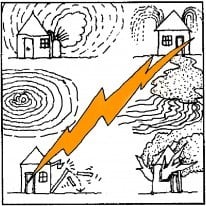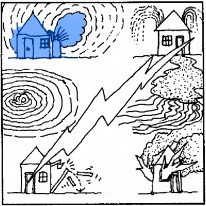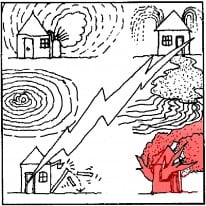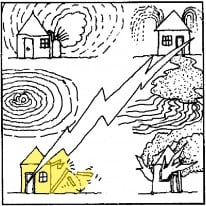Safety
When designing, upgrading or maintaining a house, immediate, life-threatening dangers must be given the highest priority. This section considers the following safety issues.
Electrocution
With national survey data of over 6,000 houses showing that only 7% of houses have safe electrical systems, electrocution has to be considered a serious risk to residents. The reason for failure could be as simple as one faulty light switch or one faulty power point, or could be an extreme combination of mice severed cabling, no earth connection of the house, faulty safety switches giving no earth leakage protection and exposed electrical cables.
A less obvious risk has emerged with the increased use of photo voltaic (PV or solar energy panels) in remote, rural and urban areas. Clear warnings in switchboards about the power sources available, and how to isolate them, will reduce chances of electrocution.
Gas explosion and asphyxiation
Data shows that gas is only available in a quarter of houses surveyed. The most common system was bottled gas (not reticulated mains gas) and less than 50% of these systems were safely installed and maintained.
Injury from fire
This section considers three important principles to reduce fire injuries - prevention, detection and escape in the event of fire.
The causes of fire may be greatly increased in houses where data show gas installations are poor with only 47% OK. Electrical faults may also lead to fires and data show that only 33% of houses had all power points testing OK. The combined impact of vermin and electrical cables can increase fire risk. Data show that mice and rats were present in almost 52% of houses, this is an increase from 47% in 2013. Mice and rats cause damage to electrical cables and to appliances such as hot water systems, refrigerators and stoves.
Detection of fire is limited by the fact that only 82% of houses have any smoke detectors fitted and, of those houses with any detector fitted, only 61% had at least one detector functioning.
Escape from house fires will be difficult if, as data show, security screens are often fixed to windows resulting in 37% of houses with the only emergency escape route possible through external doors.
Structural collapse
The immediate collapse of buildings causing injury to people is rare in Australia, but termites, reactive soils and water damage over prolonged periods has resulted in data that indicate many houses need urgent repair.
Minor trauma or physical injury such as cuts and abrasions caused by inappropriate building materials are of a lower priority. These issues are covered in section B9 ‘Reducing hazards that cause trauma’.




